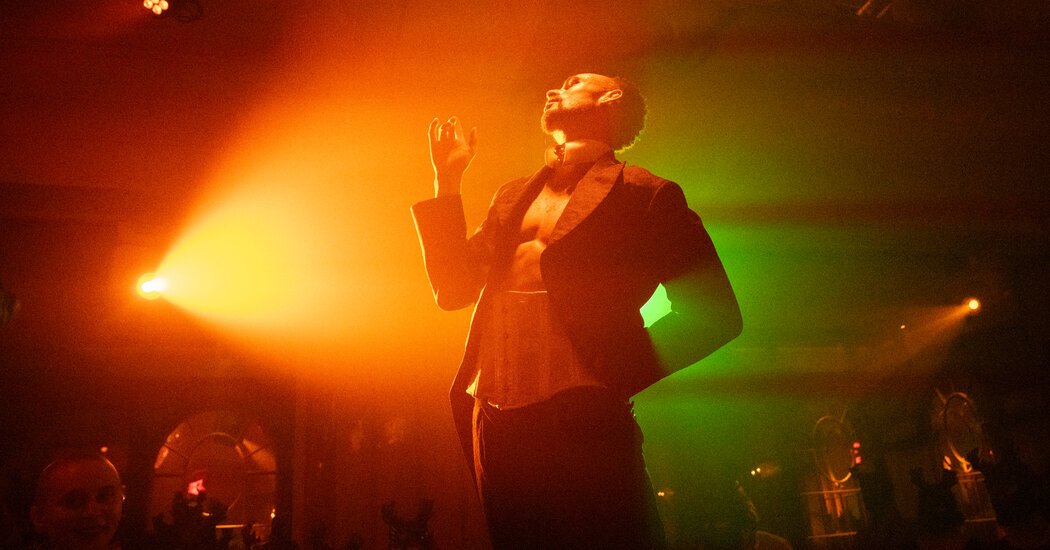In one room in Conwell Tower, a stately skyscraper in the Financial District, a police officer strips off his shirt and flogs himself — passionately, even sensually — before coolly donning his uniform again. At the end of a long hall, a woman performs a Houdini-esque escape from a straitjacket. Elsewhere, in a dark underground boxing ring, two men trade punches in a cinematic fight scene where lights flash and dim with each maneuver, the bodies sometimes moving in slow motion like scenes from a “Rocky” film.
What are these characters’ motivations, and what is their connection to one another? Your guess is as good as mine.
In “Life and Trust” — the new theatrical experience from Emursive, producers of the popular “Sleep No More” with Punchdrunk — the story never rises to meet the spectacle, creating a visually appealing yet narratively incoherent piece of exploration theater.
The show, directed by Teddy Bergman, begins on Oct. 23, 1929, the evening before the stock market crash. The audience has been invited to a “prospective investors fete” by the head of the Life and Trust Bank, a J.G. Conwell, who has made his fortune mass-producing a mysterious bright green syrup that’s something between a panacea and an addictive opiate.
There is, of course, something shady about this invitation: Early in the show a suited man purrs to the audience, “If you choose to invest with us, you’re one of ours … forever.” (It turns out “forever” means roughly three hours in this site-specific show … which can sometimes feel like an eternity.) Faced with the imminent fall of his financial empire, Conwell takes a devilish offer to travel back in time to the Gilded Age.
In this earlier time of glamour and pleasures, we meet a younger Conwell and dozens of other characters based on real historical figures, from eugenicists to magicians. The show is mostly dialogue-free; acrobatic choreography by the Tony nominees Jeff and Rick Kuperman is meant to fill some of the role speech would. Sometimes it works, as when one character shows otherworldly control over another through mirrored movements — a wave of one’s hand seems to command another’s body to tumble forward. Other instances, particularly during scenes of confrontation or seduction, when the characters’ bodies repeatedly swoon into one another, feel less novel and instead highlight how unclear the relationships and stories are.
The ominous force behind Conwell’s success is the demonic trickster Mephisto, who preys on the characters by exploiting their vices. Mephisto, played by a mesmerizing Mike Tyus in the performance I attended (the roles rotate), exudes sinister charisma, with seductive beckoning and puppet-master choreography full of serpentine twists and agile flips, and links much of the action throughout the space.
This is also a Faustian story — or, rather, stories, because, as the writer, Jon Ronson, says in a conceptual note for the production, “‘Life and Trust’ is both one show and 25 shows.” Unfortunately, not one of those 25 shows has a discernible narrative. Each figure’s back story — like, say, the immigrant vaudeville dancer with O.C.D. or a prizefighter brother with addiction issues and PTSD from the American Indian War — is too specific to be teased out by sexy dance moves and tableaus alone. The show’s attempt to critique class, capitalism and greed gets muddled or totally lost.
Another problem with the storytelling is simply logistical: You only get as much of the story as you can physically keep up with. Like “Sleep No More,” “Life and Trust” is choose-your-own-adventure theater, where each audience member can select which of the dozens of wandering, dancing, sneaking performers to follow through the various spaces.
For those looking for a new workout regimen, “Life and Trust” offers what can feel like three straight hours of cardio as you follow characters up and down the several flights of stairs in the Conwell building, often at a brisk pace. And even then the most athletic audience members may face some viewing challenges. Large plastic masks are required to be worn, which don’t serve the bespectacled folks among us, and hermetically seal in an evening’s worth of sweat. The amount of walking is a major hindrance — or totally undoable — for those with mobility issues. And the sheer mass of attendees, craning their heads and shoving their way closer to the performers, often obscures the view of anyone shorter in stature.
Away from the crowds and the fragmented bits of story, however, “Life and Trust” does work as simple eye candy. The scenic design, by Gabriel Hainer Evansohn, who also did the experience direction, creates a universe rich with colors and textures that’s delightful to explore: Venture from the old teller stations of a bank to the dark pews of a chapel, glance at the green glass vials that smirk from the cases behind a pharmacy counter, find prizes or a fortune at the fairgrounds, admire Conwell’s personal collection of curios or marvel at a luminescent garden.
“Life and Trust,” like Conwell’s special syrup, is enticing, but this formula isn’t quite magic.
Life and Trust
At the Conwell Tower, Manhattan; lifeandtrustnyc.com. Running time: 2 hours 30 minutes.
Read More: ‘Life and Trust’ Review: Choose Your Own Faustian Adventure


